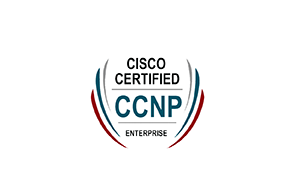Cisco CCNP Enterprise
- 30 days of instructor-led training
- Certification exam
- Soft Copy of Course material
- 100% Success Rate
- Highly experienced and certified trainers
- Free refreshment classes within 6 months

A Red Hat® Certified System Administrator (RHCSA) is able to perform the following tasks:
- Understand and use essential tools for handling files, directories, command-line environments, and documentation
- Operate running systems, including booting into different run levels, identifying processes, starting and stopping virtual machines, and controlling services
- Configure local storage using partitions and logical volumes
- Create and configure file systems and file system attributes, such as permissions, encryption, access control lists, and network file systems
- Deploy, configure, and maintain systems, including software installation, update, and core services
- Manage users and groups, including use of a centralized directory for authentication
- Manage security, including basic firewall and SELinux configuration
The RHCSA certification is designed for:
- Experienced Red Hat Enterprise Linux system administrators seeking validation of their skills
- Students who have attended Red Hat System Administration I and II and are on the path to earn RHCSA certification
- Experienced Linux system administrators who require a certification either by their organization or based on a mandate (DOD 8570 directive)
- IT professionals who are on the path to earn a Red Hat Certified Engineer (RHCE®) certification
- RHCEs who are non-current or who are about to become non-current and wish to re-certify as RHCEs
In preparation to earn the Red Hat Certified System Administrator (RHCSA), Red Hat recommends the following training modules:
- Red Hat System Administration I (RH124)
- Red Hat System Administration II (RH134)
Certification Exam : Test your skills and knowledge
EX200 – Red Hat Certified System Administrator (RHCSA) exam
- The performance-based Red Hat Certified System Administrator (RHCSA) exam (EX200) tests your knowledge and skill in areas of system administration common across a wide range of environments and deployment scenarios. You must be an RHCSA to earn a Red Hat Certified Engineer (RHCE®) certification.
RH124 : Red Hat System Administration I
The courses covering the core system administration tasks needed to manage Red Hat Enterprise Linux servers.
Red Hat System Administration I (RH124) equips you with Linux® administration “survival skills” by focusing on foundational Linux concepts and core tasks. You will learn how to apply command-line concepts and enterprise-level tools, starting you on your journey toward becoming a full-time Linux system administrator. This path continues with the follow-on course, Red Hat System Administration II (RH134).
This course is based on Red Hat® Enterprise Linux 8.
- Get started with Red Hat Enterprise Linux
Describe and define open source, Linux distributions, and Red Hat Enterprise Linux. - Access the command line
Log into a Linux system and run simple commands using the shell. - Manage files from the command line
Copy, move, create, delete, and organize files while working from the bash shell. - Get help in Red Hat Enterprise Linux
Resolve problems by using local help systems. - Create, view, and edit text files
Manage text files from command output or in a text editor. - Manage local users and groups
Create, manage, and delete local users and groups, as well as administer local password policies. - Control access to files
Set Linux file system permissions on files and interpret the security effects of different permission settings. - Monitor and manage Linux processes
Evaluate and control processes running on a Red Hat Enterprise Linux system. - Control services and daemons
Control and monitor network services and system daemons using systemd. - Configure and secure SSH
Configure secure command line service on remote systems, using OpenSSH. - Analyze and store logs
Locate and accurately interpret logs of system events for troubleshooting purposes. - Manage networking
Configure network interfaces and settings on Red Hat Enterprise Linux servers. - Archive and transfer files
Archive and copy files from one system to another. - Install and update software
Download, install, update, and manage software packages from Red Hat and yum package repositories. - Access Linux files systems
Access, inspect, and use existing file systems on storage attached to a Linux server. - Analyze servers and get support
Investigate and resolve issues in the web-based management interface, getting support from Red Hat to help solve problems. - Comprehensive review
Review the content covered in this course by completing hands-on exercises.
RH124 : Red Hat System Administration II
Red Hat System Administration II (RH134) builds upon and lends context to the foundational knowledge established in Red Hat System Administration I (RH124). This follow-on course demonstrates more detailed use cases for Red Hat® Enterprise Linux®, preparing you for the Red Hat Certified System Administrator exam (EX200).
This course is based on Red Hat Enterprise Linux 8.
- Improve command line productivity
Run commands more efficiently by using advanced features of the bash shell, shell scripts, and various utilities provided by Red Hat Enterprise Linux. - Schedule future tasks
Schedule commands to run in the future, either one time or on a repeating schedule. - Tune system performance
Improve system performance by setting tuning parameters and adjusting scheduling priority of processes. - Control access to files with ACLs
Interpret and set access control lists (ACLs) on files to handle situations requiring complex user and group access permissions. - Manage SELinux security
Protect and manage the security of a server by using SELinux. - Maintain basic storage
Create and manage storage devices, partitions, file systems, and swap spaces from the command line. - Manage logical volumes
Create and manage logical volumes containing file systems and swap spaces from the command line. - Implement advanced storage features
Manage storage using the Stratis local storage management system and use VDO volumes to optimize storage space in use. - Access network-attached storage
Use the NFS protocol to administer network-attached storage. - Control the boot process
Manage the boot process to control services offered and to troubleshoot and repair problems. - Manage network security
Control network connections to services using the system firewall and SELinux rules. - Install Red Hat Enterprise Linux
Install Red Hat Enterprise Linux on servers and virtual machines.
RELATED COURSES

"One of the best place to learn tech. Great support and amazing teachers! I'd recommend it to others, 10/10."
Abhinav Gyawali

"I completed my RHCSA and RHCE from Computer Point Nepal. The learning environment here is suited for both working professionals as well as students. From my experience tutors and staff members are very helpful. With their proper guidance I was able to complete RHCSA certification."
Avishek Pradhan

"CPN has always been a place of great learning and place to find proper guidance. They have experienced instructor who can provide guidance and suggestion about career and courses which is really helpful for beginners who want to know about career options in IT. CPN is highly recommended in my book as a place to learning and developing skills needed by both beginners and professionals alike."
Pravesh Shrestha
Red Hat StudentADDITIONAL LINKS
We accept payment by Cash, Bank Transfer, Cheque, Credit Cards, eSewa and Fonepay.
Jame Market, Ghantaghar, Kathmandu, Nepal
01-5333117 / 01-5333121
info@computerpoint.com.np
Sunday – Friday, 07:00 AM – 07:00 PM
